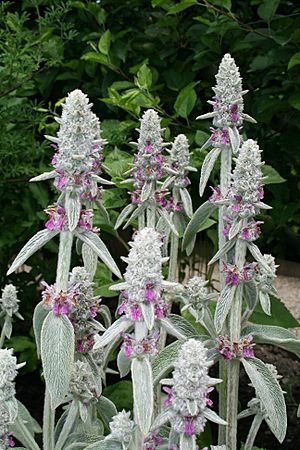Stachys byzantina facts for kids
Quick facts for kids Lamb's-ear |
|
|---|---|
 |
|
| Scientific classification | |
| Genus: |
Stachys
|
| Species: |
byzantina
|
| Synonyms | |
|
|
The Lamb's-ear (also called lamb's ear or woolly hedgenettle) is a type of flowering plant. Its scientific name is Stachys byzantina. It belongs to the mint family called Lamiaceae. This plant originally comes from places like Armenia, Iran, and Turkey.
People grow Lamb's-ear all over the world in areas with mild weather. It's a popular ornamental plant because it looks nice. Sometimes, it even grows wild in new places after escaping from gardens. You might also hear it called Stachys lanata or Stachys olympica.
Lamb's-ear usually blooms in late spring and early summer. It grows tall, spike-like stems with small, light purple flowers. The plant often stays green all year. However, if winters are very cold, it might look like it "dies" back. But don't worry, new growth will appear from its base when warmer weather returns.
Contents
What Lamb's-ear Looks Like
Lamb's-ears are herbaceous perennial plants. This means they are not woody and grow back year after year. They are covered with soft, gray or silver-white, fuzzy hairs. They get their name "lamb's ears" because their leaves are curved and feel like a lamb's soft ear.
The stems grow straight up, often with branches, and can reach 40–80 cm (about 1.5 to 2.5 feet) tall. The leaves are thick and a bit wrinkly. Both sides of the leaves are covered in fuzzy, gray-silver hairs. The undersides of the leaves are even more silver-white than the top. The leaves grow opposite each other on the stems and are about 5 to 10 cm (2 to 4 inches) long.
Lamb's-ear Flowers
The flowers grow on spikes that are 10–22 cm (4 to 8.5 inches) long. Many small flowers are grouped closely together along these spikes. The leaves on the flowering stems are much smaller than the main leaves.
The flowers themselves don't have little stalks. They have a cup-shaped part called a calyx, which is about 1.2 cm long. The petals, called the corolla, are also about 1.2 cm long. They have some darker purple lines inside. The flowers are covered in soft, silky hairs.
Growing Lamb's-ear
Lamb's-ear is a great plant for children's gardens. It's easy to grow, and its thick, fuzzy leaves are fun to touch! People also use it to create borders around garden beds.
In Brazil, some people even eat it! They call it peixinho-da-horta. It's prepared by dipping it in batter and deep-frying it. They say it tastes a bit like fish when sprinkled with lemon juice. It has also been used in the past as a medicinal plant.
There are many different types of Lamb's-ear plants, called cultivars. Some have white flowers, some grow shorter, and some don't bloom as much:
- 'Big Ears' has very large leaves, up to 25 cm (10 inches) long.
- 'Cotton Boll' doesn't produce flowers at all.
- 'Primrose Heron' has yellow leaves in spring and pink flowers.
- 'Sheila Macqueen' is a short plant with large leaves that doesn't produce flowers.
- 'Silky Fleece' grows about 25 cm (10 inches) tall with purple flowers and smaller white, fuzzy leaves.
- 'Silver Carpet' has gray leaves and also doesn't produce flowers.
- 'Striped Phantom' has leaves with different colors or patterns.
Lamb's-ear is very popular with many insects and Hummingbirds, especially bees. A special type of bee, called the Wool Carder Bee, collects the fuzz from Lamb's-ear leaves. It uses this fuzz to build its nests in old wood. Bumble bees also like to gather on Lamb's-ear leaves in the morning. They collect the water droplets that form on the fuzzy leaves from condensation.
Antibacterial Properties
Scientists have found that extracts from Stachys byzantina can help fight certain bacteria. For example, it has shown activity against Staphylococcus aureus, which is a type of bacteria that can be hard to treat.
Images for kids
See also
 In Spanish: Stachys byzantina para niños
In Spanish: Stachys byzantina para niños








